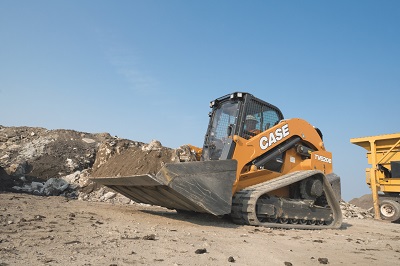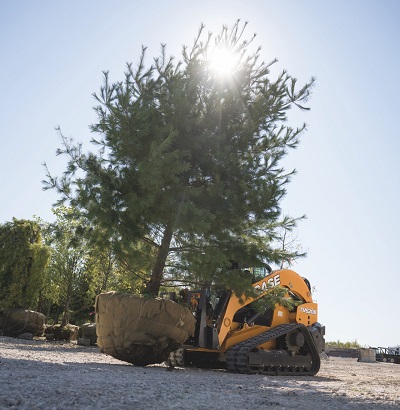In our recent post, “Auxiliary hydraulics: How to match attachments and machines,” George Macintyre and Ted Polzer of CASE Construction Equipment explained the fundamentals of auxiliary hydraulics, and how to best fit machines like skid steers and CTLs with hydraulic attachments like grapples, backhoes or brooms. Here are 11 more practical tips for any user.

What if you have an undersized hydraulic system for the attachment you want to operate?
George: If you’re running an attachment that demands a higher flow rate then the machine can supply, it’s not going to perform very well at the low flow rate. And vice versa, running a low-flow attachment in a high-flow range can damage that attachment.
Why is it important to take a long-term view when thinking about auxiliary hydraulic systems for a machine?
George: People can get frustrated with attachments, especially if you recently bought a CTL with a standard-flow system and now you’re underwhelmed with performance from a mulcher that demands high-flow. Over the last 10 years a lot more customers are looking for machines that have high-flow and enhanced high-flow systems. It might be prudent to spend bit more now so that you’re ready in the future for more-demanding attachments, and you don’t have to install an upgrade kit on the machine after the fact.
Ted: And I’d add to that, if you don’t own a lot of attachments and you’re heavily renting attachments, having a machine equipped with high-flow auxiliaries from the factory gives you the capability to be able to get attachments easier, rather than having to pick and choose through exactly which ones fit. It provides more flexibility.
George: That’s a good point, because many newer machines let the operator switch between the different hydraulic modes. So even if you have enhanced high-flow capability, it doesn’t mean that you must run an enhanced high-flow attachment. Controls within the cab lets the operator change flow rates as required.
What if a new attachment underperforms on a seemingly suitable older machine?
Ted: If you purchase a new attachment for an older machine that matches up on paper — but in reality doesn’t offer the predicted performance — check that your machine is running up to spec. If your machine has a lot of hours on it, we’ve seen that over time things like the main relief valves start to settle a little bit. Having a main relief valve in your machine operating just a couple hundred psi low can make a big difference. Your dealer can run some quick tests to determine exactly what the maximum pressure is and whether the main relief is in spec. It can save you a lot of money in productivity alone.

I have an old attachment and don’t know its recommended flow rating. How can I determine if it will work with my machine?
Ted: Reach out to the manufacturer of that attachment or to the dealer where it was purchased. Typically, dealers can look at an attachment, understand the type of motor used, or decode the specifications stamped on those components. If it’s a current production item, most dealers will be able to answer this right over the phone.
George: And check that the quick disconnects will actually mate up with the machine. A lot of the newer models have larger diameter hoses and quick disconnects. So you may need to order quick-disconnect adapter fittings in order to mate it up with the machine.
Are there any concerns with sharing attachments from machine to machine?
Ted: Yes, there are some unique considerations. If you have one attachment that’s being shared across multiple machines, and you’ve experienced some sort of a hydraulic issue with one of those machines, it’s important that you let your dealer know. If that machine was running a specific attachment, it probably needs to be involved in a cleanup process or at least an inspection. You want to avoid a hydraulic opportunity where there’s debris in a system, and then move that attachment to a known good machine, because now you are essentially introducing the same contamination. Always document and understand exactly which machines have been run with which attachments if at all possible.
What’s the preferred way to store attachments?
Ted: When attachments are not being used, they’re typically out in the elements with the hoses exposed. Make sure that when storing attachments, you prevent hydraulic couplers for the hose ends from lying on the ground. Get them out of the mud and try to keep them covered and protected as much as possible. Some operators prefer to snap them together, which is another option. And prior to coupling up to any machine, make sure that the connection points on the manifold, and the hose connections on the attachment side, are extremely clean. It helps maintain the full capability of your machine.
Any advice on how to efficiently disconnect attachments?
George: The most important practice when you release an attachment from a skid steer or CTL is to immediately relieve the pressure. On the attachment itself, we highly recommend that you connect the hoses together to equalize the pressure throughout that attachment. Second, we recommend that you relieve the pressure on the skid steer or CTL right away as well. On the TV620B CTL, for example, you do that by pushing in the two outside quick disconnects, which relieves pressure in the system through the middle case drain. That practice holds whether you’re running a standard-flow, high-flow or enhanced high-flow hydraulic system. Operators get into trouble, say on hot days, when they don’t take those two steps. It becomes much more difficult to relieve the pressure later on.
What about electrical connectors?
George: The 14-pin electrical connections are standard equipment on all CASE skid steers and CTLs, except for the small SR160B model. Some other manufacturers offer seven- or eight-pin connectors. There are companies — Skid Steer Genius is one — that sell adapters for mating attachments and machines when the connectors differ.
Any considerations for hydraulic fluid in cold weather?
Ted: Focus on your machine. If the climate suggests that you need to run a specialty oil, such as a cold-weather synthetic type of oil, as soon as you hook up and engage that attachment, the oil will flow through and mix together. That’s not a huge concern. It is normal to have that type of a scenario with skid steers. The attachment will see the same benefits as your machine.
I have 20 year old attachments still in good working order. Can I run them on current skid steers and CTLs?
Ted: Yes, but you need to go through the normal considerations. Does your attachment coupler mate up? Do you need to change the quick disconnects so that they fit newer machines? Find the specifications, as it’s important that you are not putting a 50 hydraulic hp attachment on a 100 hydraulic hp machine. Maximum flow could be another issue. Keep in mind that lot of older attachments operated at lower flow rates as well as a lower main relief pressure. So those should be some key considerations.
Can I use attachments from other manufacturers on CASE skid steers and CTLs?
George: Absolutely. However, make sure that you are using an OEM-approved attachment. CaseCE engineers work with many different attachment suppliers. But when we do see issues, invariably it’s because a customer bought an attachment from an unknown supplier that didn’t necessarily understand the specs on the machines. And that’s where you really start to run into problems. Also, take into consideration some of the things that we’ve discussed previously, such as the type and size of the quick disconnects and electrical connections.
CASE Construction Equipment
www.casece.com
Filed Under: Mobile Hydraulic Tips